论文发表
18. Yong-Kang Zhang, An-Guo Wu, Liang-Nian He*. Hydrogen Atom Transfer-Mediated N‑heterocycles Dehydrogenation Coupled with the CO2 Photoreduction to Syngas. J. Am. Chem. Soc. 2025, 147, 31482-31487. [Link]
15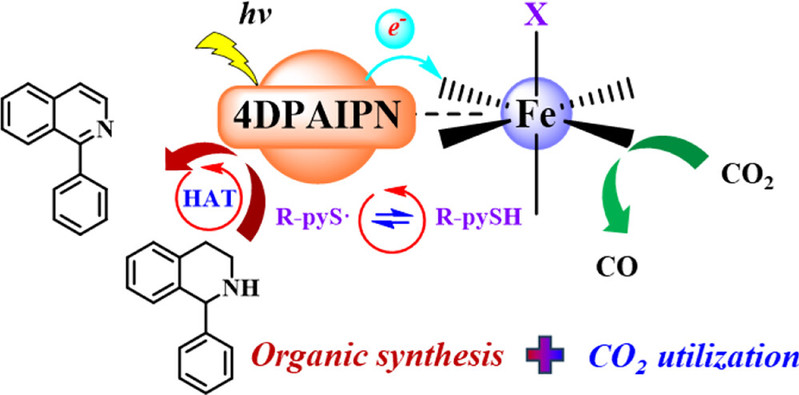
Abstract: Homogeneous photocatalytic organic oxidation coupled with CO2 reduction remains challenging due to the susceptibility to a back electron transfer scenario. Herein, a pyridinethiol iron-catalyzed system is developed to achieve N-heterocycles dehydrogenation coupled with CO2 photoreduction to syngas. The system is comprised of 2,4,5,6-tetrakis(diphenylamino)isophthalonitrile (4DPAIPN) photoredox catalysts, earth-abundant iron catalysts, and pyridinethiol organocatalysts, and the employment of pyridinethiol both as a hydrogen atom transfer (HAT) catalyst to promote N-heterocycles dehydrogenation and as an effective ligand for CO2 reduction is the key to realizing the coupled redox reaction. Experimental and theoretical calculation results demonstrate the positive correlation between the reactivity and the S–H bond dissociation enthalpy (BDE) as well as the radical polarity (ω) parameter, gaining deep insights into understanding and designing the coupled reaction.
17. Xiangyang Yao, Wen-Jun Xie, Liqi Qiu, Liang-Nian He*. Organic Bases-Mediated CO2 Photoreduction Coupled with N-Heterocycle Dehydrogenation. ChemSusChem2025, 00, e202501750. [Link]
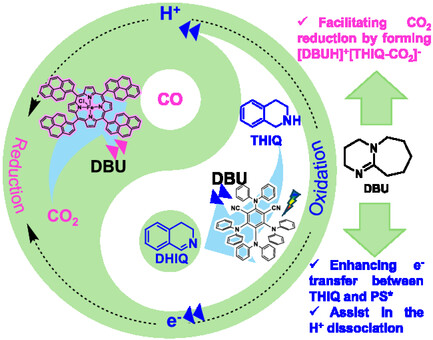
Abstract:Photocatalytic CO2 reduction to value-added chemicals is a pivotal approach toward achieving carbon neutrality. However, conventional photocatalytic systems typically rely on sacrificial electron donors that are unsustainable and yield low-value oxidation byproducts, thereby limiting their economic viability. In this work, a dual-functional photocatalytic architecture is reported, which is based on pyrene-appended iron porphyrin and organic photosensitizer in combination with 1,8-diazabicyclo[5.4.0]undec-7-ene (DBU) that achieves integrated redox transformations under visible light, addressing charge separation challenges. This system enables the simultaneous reduction of CO2 to CO with 98% selectivity (turnover number, TON=288), coupled with the oxidative semidehydrogenation of 1,2,3,4-tetrahydroisoquinoline (THIQ) to 3,4-dihydroisoquinoline (DHIQ) (TON=273), indicating excellent coupling efficiency of the redox reactions. Mechanistic investigations, including spectroscopic analysis and density functional theory calculations, have elucidated the pivotal role of DBU as a base and electron-transfer mediator in redox coupling reaction that is meticulously designed. This strategy offers an effective approach to sustainable photocatalytic platforms and underscores the potential of utilizing multifunctional additives to optimize both catalytic performance and reaction selectivity.
16. Chengguang Yue, Jiaxin Li, Mei-Yan Wang*, Zhiyi Yang, Tiantian Xiao, Ji Qi, Shouying Huang, YueWang, Liang-Nian He* and Xinbin Ma*. Oxygen vacancy-hydroxyl frustrated Lewis pairs enabling CO2 cycloaddition for halogen-free synthesis of cyclic carbonates. Green Chem. https://doi.org/10.1039/D5GC04831A
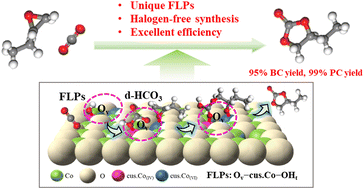
Abstract: Electronic-grade cyclic carbonates, synthesized via the cycloaddition of CO2 with epoxides, are important reagents widely used as lithium-ion battery electrolytes, polar aprotic solvents, and polymer monomers. However, current manufacturing processes rely on halide-containing catalysts, which lead to equipment corrosion and high energy consumption during product purification. The development of halogen-free catalysts is significant for enabling a greener upgrade of cyclic carbonate production. Here, a series of Ov-induced surface hydroxylated cobalt oxide catalysts (Co3O4−x(OH)y-T) were developed. Unique frustrated Lewis pair (FLP) structures consisting of Ovs and terminal hydroxyl groups attached to adjacent coordinately-unsaturated cobalt (Ov–cus.Co–OHt) were successfully fabricated on the Ov- and hydroxyl-enriched cobalt oxide surfaces. The most FLP-abundant catalyst, Co3O4−x(OH)y-170, shows excellent catalytic activity, achieving 95% yield of butylene carbonate and 99% yield of propylene carbonate under halogen-free conditions. Experimental and DFT calculation results reveal that the FLP structures not only improve CO2 adsorption but also favor intermediate desorption via forming a metastable d-HCO3 species, which breaks the tradeoff between CO2 adsorption and intermediate dissociation and enhances the catalytic activity of the developed cobalt oxide catalysts. The findings in this work provide a novel strategy for the green synthesis of cyclic carbonates.
15. Mikhail M. Doronin, Alexander S. Klikushin, Olga M. Mulina, Michael G. Medvedev, Vera A. Vil’, Liang-Nian He and Alexander O. Terent'ev*. α-Sulfonylated ketazine synthesis from vinyl azides and sodium sulfinates using CAN: radical C–S/N–N coupling cascade as a key reaction pathway. Org. Chem. Front., 2025, 12, 5271–5278. [Link]

Abstract: Synthesis of α-sulfonylated ketazines from vinyl azides and sodium sulfinates proceeding via radical C–S/N–N coupling cascade has been developed. The cascade starts from the generation of sulfonyl radicals through RSO2Na oxidation by cerium(IV) ammonium nitrate (CAN). Their addition to the double bond of vinyl azides, followed by N2 elimination, leads to the formation of iminyl radicals, whose N–N coupling provides α-sulfonylated ketazines in yields up to 96%. This process represents one of the rare facets of iminyl radical reactivity, namely, N–N radical coupling while bypassing their reduction, intramolecular cyclization, and 1,n-HAT that are typical for them. The EPR-spectra study and quantum chemical calculations revealed that the selective N–N coupling of iminyl radicals was facilitated by the inertness of Ce(III) towards coordination with iminyl radicals and the inaccessibility of charge transfer. In contrast, Mn(II) coordinates with iminyl radicals and converts them into enamines.
14. Valerio D’ Elia*, Pichaya Pattanasattayavong, Liang-Nian He*. 4-Aminopyridines as Versatile “Noninterfering” Allies for CO2 Fixation. ChemCatChem 2025, https://doi.org/10.1002/cctc.202501150.
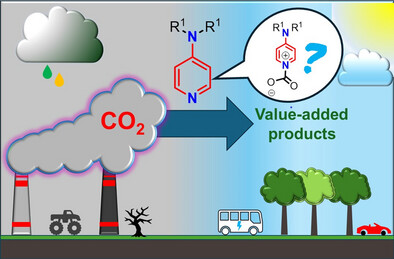
Abstract: Organic superbases are a family of compounds endowed with high nucleophilicity and basicity. Several powerful nucleophiles such as DBU (1,8-diazabicyclo[5.4.0]undec-7-ene), TBD (1,5,7-triazabicyclo[4.4.0]dec-5-ene), or DMAP (4-dimethylaminopyridine) are involved in CO2 conversion but their catalytic roles may differ from a mechanistic standpoint. In this work, we show the versatile application of 4-aminopyridines in CO2 fixation leading to products of CO2 reduction as well as cyclic carbonates and fine chemicals. In such cases, 4-aminopyridines serve not just as organocatalysts, but as recurring motifs performing as bases, structural components, ligands for electronic modulation of metals and full-fledged catalytic components. Such roles are highlighted herein with an eye to the understanding of mechanistic aspects and the interaction between 4-aminopyridines and CO2 through the discussion of several catalytic studies.
13. Jie Ding, Wen-Jun Xie, An-Guo Wu, Li-Feng Xu, Ming Zhang, Hong-Ru Li, Liang-Nian He*. Nickel-Catalyzed Stereoselective Synthesis of Dihydrobenzofuran Exocyclic Alkenyl Carboxylic Acids from CO2. Org. Lett. 2025, 27, 11446-11451. [Link]

Abstract: An earth-abundant nickel-catalyzed Heck type cyclization/carboxylation of iodoarene-tethered propargyl ethers using CO2 as the C1 source was developed herein. This protocol affords a series of exocyclic alkenyl carboxylic acids bearing a dihydrobenzofuran scaffold with exclusive syn-selectivity. Gram-scale experiments demonstrate the scalability of this transformation, and the products undergo further functionalization through aromatization or esterification with eugenol, indicating potential application.
12. Zheng-Zheng Meng, Lan Zhao, Wen-Jun Xie. Liang-Nian He*. Electrochemical Carboxylative Cyclization of Propargylamines with CO2 to Functionalized 2-Oxazolidinones. J. Org. Chem. 2025, 90, 13784–13788. [Link]

Abstract: The electrochemical conversion of CO2 into value-added chemicals represents a promising strategy for sustainable synthesis. Herein, we report a novel electrochemical carboxylative cyclization of propargylamines with CO2 to access exocyclic iodo-carboxyl-vinylene 2-oxazolidinones bearing two CO2 moieties by using tetraethylammonium iodide (Et4NI) as both the electrolyte and the “iodine source”, which enables the one-pot construction of C–O, C–C, C–N, and C–I bonds. The protocol proceeds under mild conditions and accommodates a broad range of substrates, providing access to functionalized 2-oxazolidinones with high structural complexity.
11. Xiangyang Yao, Liqi Qiu, Wen-Jun Xie, Liang-Nian He*. Switchable CO2 Photoreduction Selectivity via Organic Bases in Dual-Component Earth-Abundant Metal Systems. ACS Sustainable Chem. Eng. 2025, 13, 10223-10232. [Link]
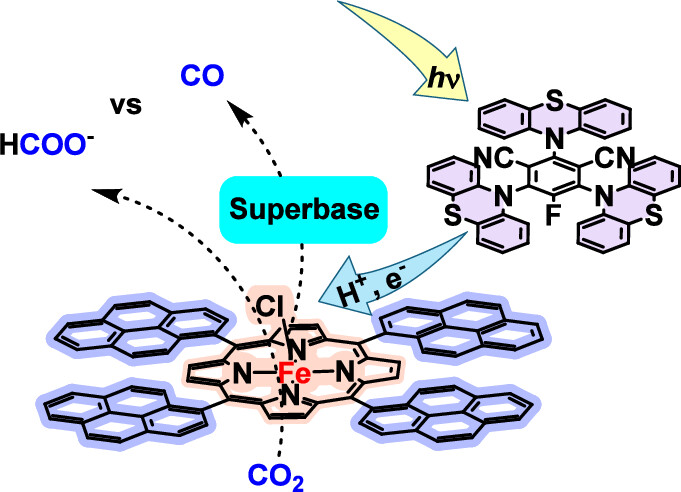
Abstract: Photocatalytic CO2 reduction is a promising strategy for carbon-neutral fuel production, especially if highly selective catalysts based on earth-abundant metals can be developed. In this work, we demonstrated that the addition of organic bases to a dual-component photocatalytic system can switch the selectivity toward formate and carbon monoxide (CO). The system in this study consists of a pyrene-modified iron porphyrin catalyst and an organic donor–acceptor cyanoarene photosensitizer. Under visible light irradiation without any bases, formate emerged as the predominant product, achieving a turnover number (TON) of 1694 and 71% selectivity. Upon introducing an organic base, the product distribution shifted toward CO. Notably, upon addition of 7-methyl-1,5,7-triazabicyclo[4.4.0]dec-5-ene (MTBD), the CO selectivity increased to 84%, with a TONCO of 1787. Mechanistic studies indicated that the organic base shifts the nucleophilic active species from a hydride ([FeIHL]2–) to a [Fe0L]2– that can directly attack CO2 thereby leading to different reaction pathways and tuning the product selectivity.
10. Weibin Xie, Peizhuo Li, Jinmin Peng, Yue Chen, Jieyin Liu, Xiaochen Wang, Zhiguang Yuchi, Liangnian He*, Yuxin Li*. Novel boron-containing anthranilic diamide derivatives: design, synthesis, and exploration of the action mode against lepidopteran insects. Pest Manag Sci. 2025, 81, 6385-6403. [Link]
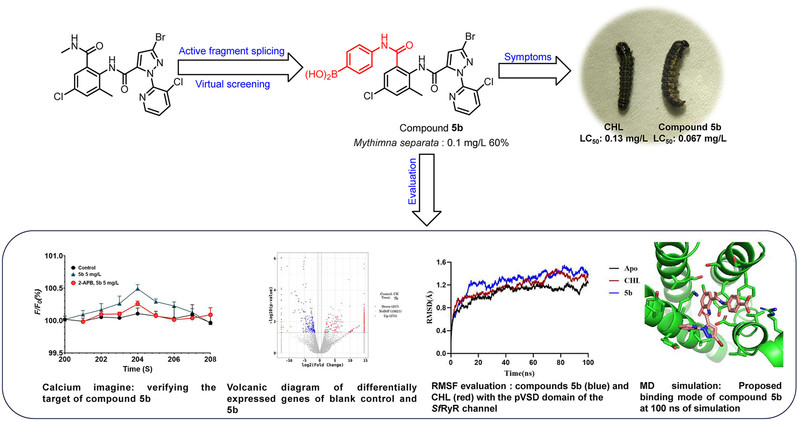
Abstract: Nineteen boron-containing anthranilic diamide derivatives were designed and synthesized on the basis of the structure of chlorantraniliprole (CHL), utilizing active fragment splicing and virtual screening. Compound 5b showed extremely high activity against Mythimna separata (60%) at 0.1mg/L, comparable to that of CHL (40%). In addition, compound 5b could stimulated the growth of corn. The calcium imaging technique in combination with time-lapse [Ca2+]ER measurements and transcriptomic analyses verified that the targets of compound 5b might be calcium channels, distinct from CHL. The binding mode of compound 5b in ryanodine receptors (RyRs) was predicted via molecular docking analysis and compound 5b could maintain stability after binding with SfRyR.
9. Hong-Ru Li*, Chao-Yang Jing, Shan-Shan Chen, Alexander O. Terent'ev and Liang-Nian He*. Electrolytic olefin epoxidation for sustainable synthesis of epoxy compounds. Green Chem.,2025, 27, 9414-9438. [Link]
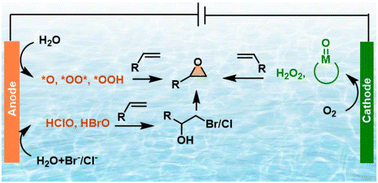
Abstract: Electrolytic olefin epoxidation is regarded as a sustainable method for epoxy compound synthesis with only oxygen or water as the oxygen atom source under mild conditions. After decades of slow development, this field is currently experiencing a renaissance and has been brought back to the spotlight with the emergence of novel electrode materials. Nowadays, various strategies have been developed for electrolytic olefin epoxidation, including olefin epoxidation initiated by O2 reduction at the cathode and direct/indirect olefin epoxidation promoted by water oxidation/redox mediators at the anode. Concurrently, a plethora of efficient and robust electrode materials such as PtPdOx, IrO2/TiO2, PdO and so on have been developed for olefin epoxidation via the direct oxygen atom transfer (OAT) mechanism or halide-mediated halohydrin formation and cyclization. As a result, the overoxidation of olefins to CO2 can be inhibited and high atom economy can be achieved. This review aims to provide an overview of the state of the art in electrolytic olefin epoxidation and reflect the green advances in electrochemical epoxidation of olefins such as the atom economical pathway with only oxygen or water as the oxygen donor under mild conditions, avoiding overoxidation of olefins to CO2 in conventional processes and reducing the use of heavy metal reagents. Moreover, the perspectives are also presented to spur further development in this field.
8. Shumei Xia, Jiaoyu Peng, Shaolei Xie, Taoshan Xu, Lijuan Li, Xin Liu, Dawei Cao*, Liang-Nian He*, Chao-Jun Li*. Copper-Catalyzed Chemoselective Hydrogenation of Unsaturated Bonds with Formic Acid/Formate as Hydrogen Donor. Org. Lett. 2025, 27, 5423-5428. [Link]
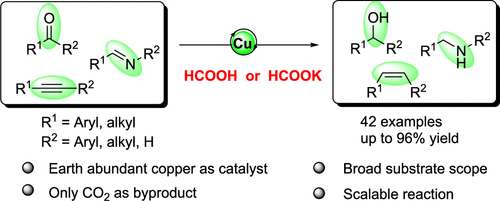
Abstract: A novel and sustainable strategy, using earth abundant Cu2O as catalyst and biorenewable HCOOH/HCOOK as hydrogen donor for the efficient hydrogenation of multiple unsaturated compounds, including internal and terminal alkynes, ketones, aldehydes, and imines, has been developed to access high-value chemicals with high chemoselectivity. This protocol features operation simplicity, wide substrate applicability, and only CO2 as a byproduct. Additionally, gram-scale experiments and the modification of biologically active molecules all exemplified the synthetic versatility of this protocol.
7. Lan Zhao, An-Guo Wu, Hong-Ru Li, Alexander O. Terent’ev, Liang-Nian He*. Electrochemical Deaminative Carboxylation of Aryltriazenes with CO2 to Aryl Carboxylic Acids. Org. Lett. 2025, 27, 4553–4558. [Link]

Abstract: The utilization of CO2 as an appealing chemical feedstock for diverse synthetically valuable products is constantly evolving, potentially alleviating chemical production that relies on petrochemistry. Herein we report the first example of the electrochemical deaminative carboxylation of aryltriazenes with CO2. The reaction can be performed under mild and catalyst-free conditions by using sustainable methods with CO2 as a green C1 building block, efficiently converting a diverse range of readily available aryltriazenes into synthetically valuable carboxylic acids. In particular, the formation of C–C bonds by deaminative carboxylation would be an impactful addition to the synthesis toolbox.
6. Jie Ding, Ming Zhang, Shanshan Chen, Hong-Ru Li*, Liang-Nian He*. strategy for the reductive transformation of carbon dioxide: carbonylation of unsaturated hydrocarbons. Sci. Sin. Chim., 2025, 55(5): 1277-1296. [Link]
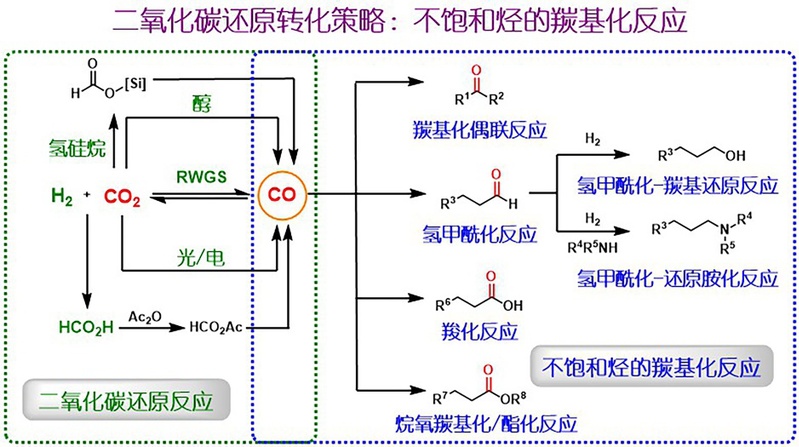
Abstract: The reductive transformation strategy integrates CO2 first reduction to CO with subsequent carbonylation reactions of unsaturated hydrocarbons with the CO in situ generated, resulting in the formation of high-value chemicals such as aldehydes, carboxylic acid esters, alcohols, and amines. This cascade approach not only avoids the direct handling of toxic CO, offering a safe and sustainable synthetic route for chemical production, but also expands the scope of CO2-based chemicals. Consequently, CO2 reductive functionalization holds significant scientific importance and promising application prospects. In this review, the CO2 reductive transformation paths are classified initially and summarized according to initial thermocatalytic reduction steps with various reducing agents such as hydrogen, alcohols, hydrosilanes, as well as photo/electro-reductions. Furthermore, the reductive carbonylations of unsaturated hydrocarbons including olefins, alkynes, and allenes with CO2 are in detail discussed through such reductive functionalization approaches along with efficient catalysts development on the basis of reaction mechanistic understanding on a molecular level. Finally, the challenges in this field are discussed and future directions are proposed with insights into potential advancements accordingly.
5. Fang-Yu Ren, Chaopeng Hu, Wen-Bin Huang, Ling-Hao Duan, Yun-Zhu Meng, Xiu-Lan Li, Zhi Fang, Xin-Yuan Zhao, Wen Wang, Xiang-Shuai Li, Jian Zhao, Xiang-Yu Zhang, Sheng-Li Hou, Hang Xu, Ying Shi, Prof. Liang-Nian He*, Prof. Bin Zhao*. Modulated Multicomponent Reaction Pathway by Pore-Confinement Effect in MOFs for Highly Efficient Catalysis of Low-Concentration CO2. Angew. Chem. Int. Ed. 2025, 64, e202503898. [Link]
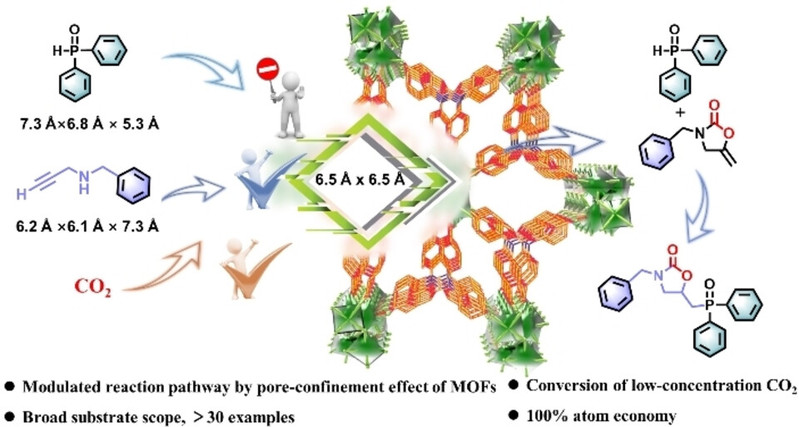
Abstract: The conversion of flue gas CO2 into high-value chemicals via multicomponent reactions (MCRs) offers the advantages of atom economy, bond-formation efficiency and product complexity. However, because of the competition between reaction sequences and pathways among substrates, the efficient synthesize the desired product is a great challenge. Herein, a porous noble-metal-free framework (Cu-TCA) was synthesized, which can highly effectively catalyze the multicomponent conversion of CO2 by modulating reaction pathways. The pores with the size of 6.5Å×6.5Å in Cu-TCA selectively permit the entry of propargylamine and CO2 at simulated flue gas concentrations, At the same time, the larger-sized phosphine oxide is hindered outside the pores. Control experiments and NMR spectroscopy revealed that CO2 and propargylamine in the pores preferentially reacted to form oxazolidinones, which further reacted with phosphine oxide outside the pores to produce phosphorylated 2-oxazolidinones. Therefore, the reaction pathways and sequence of the substrates were controlled by the confinement effect of the pores in Cu-TCA. Density functional theory (DFT) calculations supported the coordination of Cu-TCA with the alkyne, significantly reducing the reaction barrier and promoting catalytic reaction. This study developed a new strategy for regulating the reaction pathways to promote MCRs via the confinement effect of MOF.
4. Yong-Kang Zhang, Lan Zhao, Alexander O. Terent’ev,b Liang-Nian He* Dynamic Pyridinethiol Ligand Shuttling within Iron-Anchored Covalent Organic Frameworks Boosts CO2 Photoreduction. J. Mater. Chem. A. 2025, 13, 1407-1419. [Link]
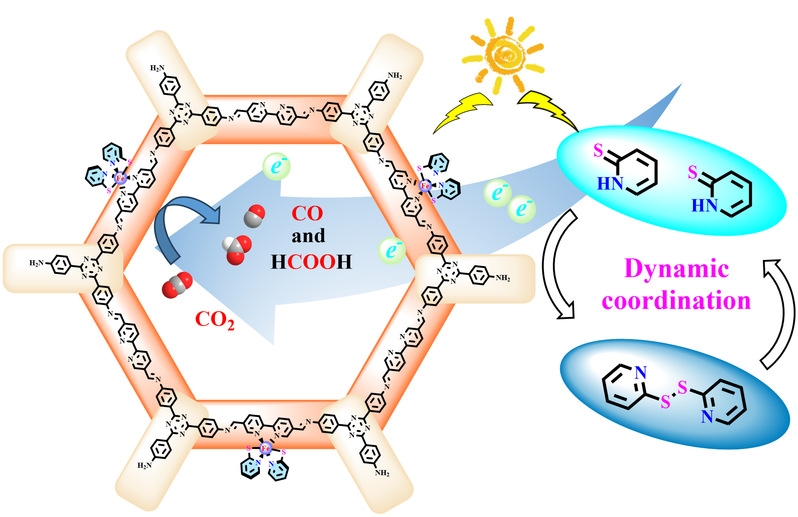
Abstract: Covalent organic framework (COF), as a porous crystalline material, provides a versatile platform for photocatalytic CO2 reduction reaction (PCO2RR). However, the lack of surface redox active sites and rapid photogenerated charge recombination are the major barriers limiting further enhancement of PCO2RR activity. Herein, we designed a novel photocatalytic system constructed from a dynamic D··M-A structure COF. The earth abundant metal iron sites were embedded into the triazinyl COF structure containing bipyridine units (Fe-bpy-COF), and the subsequent supplementation of pyridinethiol to the system allowed efficient CO2 photoreduction without additional photosensitizers. Remarkably, the Fe-bpy-COF system achieved an impressive formate yield of 4052 μmol g-1 h-1 and CO yield of 2123 μmol g-1 h-1, being over approximately 8.2-fold higher than that of the previously reported Re-COF under visible light irradiation. On the basis of 1H NMR titration experiments and steady-state tests of the absorption spectra, the superior photocatalytic performance is accordingly attributed to the dynamic coordination interaction between the pyridinethiol ligands and Fe-bpy-COF host, thus facilitating continuous double-electron transfer from the pyridinethiol ligands to the iron center under visible light and inhibiting photogenerated charge recombination in Fe-bpy-COF. Finally, the reaction pathways of CO2 conversion catalyzed by the reductive iron active species are elucidated by combining experimental results and density functional theory study. This provides unprecedented insights into the design of earth abundant metal-derived COF photocatalysts for efficient and selective CO2 reduction under visible light.
3. Dmitri I. Fomenkov, Roman A. Budekhin, Olga M. Mulina, Olga Komarova, Mikhail M. Doronin, Yulia Yu. Belyakova, Liang-Nian He, Ivan A. Yaremenko, Alexander O. Terent'ev*. Ring Opening and C(ω)-S Coupling: Nickel-Mediated Transformation of Alicyclic Alkoxyhydroperoxides. Eur. J. Org. Chem. 2025, 28, e202401198 [Link]
Abstract: Ozonolysis of cycloalkanone semicarbazones in alcohol containing solution with the subsequent addition of nickel (II) dithiocarbamates or xanthates was found to result in ω-xanthyl or ω-dithiocarbamyl carboxylic acid esters. The reaction proceeds in several steps. The initial one is cycloalkanone semicarbazone ozonolysis in the presence of alcohol, which leads to alicyclic alkoxyhydroperoxide. The second step is an extraordinary interaction between the alkoxyhydroperoxide and nickel (II) dithiocarbamate or xanthate, which proceeds via alkoxy radical formation and its subsequent β-scission, resulting in C-S coupling products. The developed method allows to obtain ω-xanthyl or ω-dithiocarbamyl esters in yields up to 52% relative to the initial cycloalkanone semicarbazone.
2. Zheng-Zheng Meng, Shan-Shan Chen, Hong-Ru Li*, Liang-Nian He*. Heterogeneous Catalysis for Aerobic Oxidation of 5-Hydroxymethylfurfural to 2,5-Furandicarboxylic Acid under Base-Free Conditions. ChemCatChem 2025, 17, e202401658. [Link]
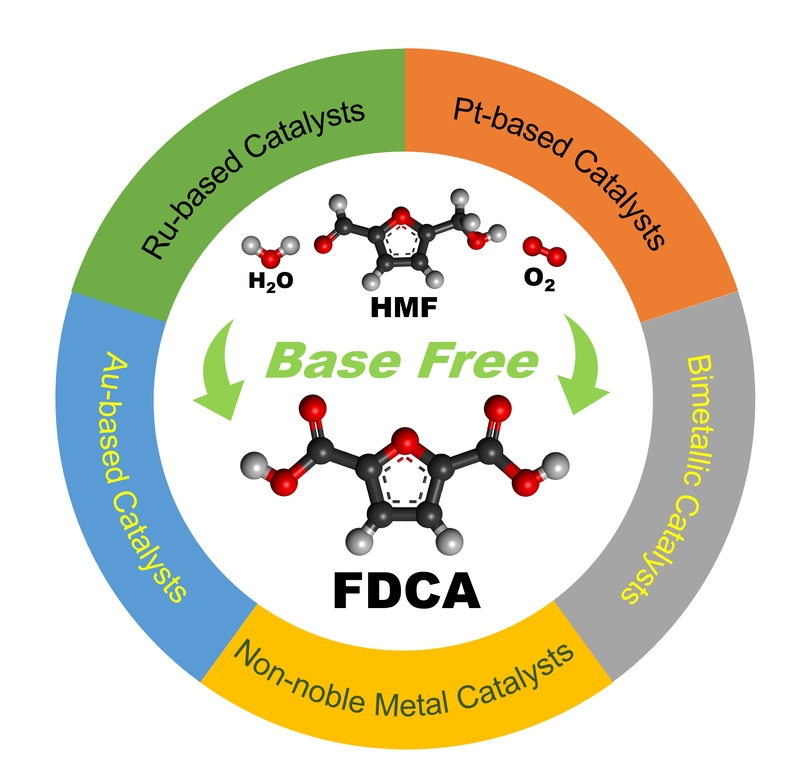
Abstract: 2,5-Furandicarboxylic acid (FDCA) is a biomass-derived monomer for the production of poly(ethylene 2,5-furandicarboxylate) (PEF), which is a novel polyester that can serve as a sustainable alternative to traditional petroleum-based poly(ethylene terephthalate) (PET). Currently, the industrial production of FDCA depends on the thermo catalytic aerobic oxidation of 5-hydroxymethylfurfural (HMF) using heterogeneous catalysts in aqueous solution, in which process equivalent homogeneous bases are usually needed to promote the oxidation of hydroxymethyl and aldehyde groups and simultaneously improve the solubility of oxidative products via forming carboxylate. The involvement of massive base causes risks of equipment corrosion and necessitates subsequent product separation and purification with a large amount acid. In this context, the base-free aerobic oxidation of HMF to FDCA has attracted much concern. Nowadays, by developing supported catalysts with multiple catalytic sites, using diluted substrate and finding good solvent for FDCA, much progress has been achieved in this field. This review provides the state of the art of the heterogeneous catalysis for aerobic oxidation of HMF to FDCA under base-free conditions, highlighting the catalytic mechanism to shed light on the catalyst design principles.
1. 何良年*, 李红茹, 谢汶均, 武安国, 赵兰, 张永康, 姚向阳, 陈金梅. 二氧化碳化学转化的科学基础及其路径. 科学通报, 2025, 70, 1937-1953. [Link]
摘要:二氧化碳(CO2)既是主要的温室气体,也是丰富的可再生资源,通过催化转化可定向制备为化学品、能源产品与功能材料,即实现“变废为宝、高值化利用”的资源化利用过程。因此,面向资源化/能源化利用的二氧化碳化学研究,对于可持续发展具有重要意义及应用前景。二氧化碳资源化利用的贡献不仅仅局限于减排的绝对量,更重要的意义与价值在于:1)减缓化工生产对化石资源的依赖,2)提供更加环境友好的生产方法,减少化工生产对环境的影响,3)在一定程度上调节碳循环。我们试图从热力学、动力学角度分析CO2转化反应所涉及的CO2活化、能量问题、作用机制和催化剂的理性设计等科学基础,并提出相应的转化途径。本文基于CO2分子活化原理认识及转化路径分析,介绍CO2资源化领域的现状,分析所面临的挑战;主要包括热催化转化及反应类型、电催化CO2还原及电羧化反应、光催化CO2还原及光驱动CO2参与的有机反应,并简要介绍过程耦合、接力催化等策略及生物催化和耦合策略、等离子体催化技术在二氧化碳资源化中的应用。总之,对于二氧化碳化学的基础科学认识,为发展二氧化碳资源化新反应、新方法与新技术提供理论支撑,推动二氧化碳基产品的规模化生产与工业应用